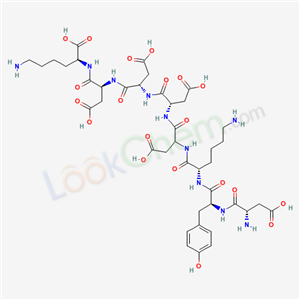- +86 15383000851
- +86 15303238802
- admin@hebeianda.cn
Your Location:Home >Products >Others >98849-88-8


Purity:99%
|
Biological Activity |
a fusion tag called dykddddk and consisting of eight amino acids asp-tyr-lys-asp-asp-asp-asp-lys including an enterokinase-cleavage site, was specifically designed for immunoaffinity chromatography. it allows elution under non-denaturing conditions. several antibodies against this peptide have been developed. one antibody, denoted as m1, binds the peptide in the presence of bivalent metal cations, preferably ca+. elution is effected by chelating agents. another strategy is competitive elution with excess of free dykddddk peptide. antibodies m2 and m5 are applied in this procedure1.the added marker segment is that it should not interfere with the native folding of proteins to which it is attached. secondly, the marker peptide sequence should be water-soluble and should retain a high degree of exposure on the surface of the protein, so that it can readily interact with its ligand. it should also be suitable for a mild and inexpensive affinity purification procedure. finally, an easy removal of the marker peptide leading to a native product is also advantageous. due to this small size, the marker peptide can be encoded by a single synthetic oligonucleotide. it is known that aromatic amino acids are the major factors in antigen–antibody interactions.lys at position 3 in the marker sequence leads to a hexapeptide sequence lysaspaspaspasplys, which ensures a maximum value on the hydrophilicity scale according to hopp and woods2 . such hydrophilic sequences have been shown to express strong antigenicity and are thus likely to adopt a highly exposed conformation in the three-dimensional folding of proteins3. another virtue of dykddddk is that the longest trypsinogen prosequences are of this length. this enables the removal of the tag and the production of an authentic n-terminus of the fusion protein partner by enterokinase treatment. the dykddddk peptide can be fused to either the n- or c-terminus of a given fusion protein. nevertheless, the n-terminal fusion has several advantages. inhibition elisa experiments showed that the anti-dykddddk antibody m1 binds three to four orders of magnitude better under conditions where the a-amino group of the first amino acid is freely accessible4.the dykddddk marker peptide fusion system comprises a unique and widely useful technique for protein identification and purification. elution of the fusion protein can be accomplished either by antibody-mediated affinity chromatography in a calcium-dependent manner, by lowering the ph, or by competitive elution with synthetic peptides1. although highly selective, the binding capacities are low, making scale-up a costly undertaking. in addition to cost and low capacity, large-scale immunoaffinity chromatography, applied to the production of therapeutic proteins has several disadvantages: ligand leakage, instability, and need for validation of antibody production. the stability of the affinity chromatography column depends on the nature and source of the crude extracts. furthermore, the dykddddk tag, designed to be immunogenic, must be removed from therapeutic proteins. in most cases, this can be accomplished with enterokinase. however, contaminating proteases may also produce undesired cleavages. despite these drawbacks, the dykddddk fusion is useful in research and development: dykddddk proteins can be readily purified and assayed by elisa or any other immunochemical detection method, thus expediting the raising of antisera against a desired protein and characterization studies. |
| Uses | Flag-tag is a commonly used epitope or peptide tag that is not derived from a natural protein. |
|
references |
1. a. einhauer, a. jungbauer. the flag peptide, a versatile fusion tag for the purification of recombinant proteins. j. biochem. biophys. methods 49 2001 455–465. 2. hopp tp, woods kr. prediction of protein antigenic determinants from amino acid sequences. proc natl acad sci u s a 1981;78:3824–8.3. hopp tp. protein surface analysis: methods for identifying antigenic determinants and other interaction sites. j immunol methods 1986;88:1–18.4. power be, ivancic n, harley vr, webster rg, kortt aa, irving ra, et al. high-level temperature-induced synthesis of an a |
InChI:InChI=1/C41H60N10O20/c42-11-3-1-5-22(45-36(65)24(13-19-7-9-20(52)10-8-19)47-34(63)21(44)14-29(53)54)35(64)48-26(16-31(57)58)38(67)50-28(18-33(61)62)40(69)51-27(17-32(59)60)39(68)49-25(15-30(55)56)37(66)46-23(41(70)71)6-2-4-12-43/h7-10,21-28,52H,1-6,11-18,42-44H2,(H,45,65)(H,46,66)(H,47,63)(H,48,64)(H,49,68)(H,50,67)(H,51,69)(H,53,54)(H,55,56)(H,57,58)(H,59,60)(H,61,62)(H,70,71)/t21-,22-,23-,24-,25-,26?,27-,28-/m0/s1
The FLAG epitope is an eight amino acid peptide (AspTyrLysAspAspAspAspLys) that is useful for immunoaffinity purification of fusion proteins. A monoclonal antibody (anti-FLAG M1) that binds the FLAG epitope in a calcium-dependent manner and requires an N-terminal FLAG sequence has been described previously....
The FLAG peptide, AspTyrLysAspAspAspAspLys, has been used as an epitope tag in a variety of cell types. The modification of the cytomegalovirus (CMV) promoter containing vector, pCMV5, to create two transient expression vectors designed for secretion and intracellular expression of FLAG-fusion proteins in mammalian cells is described. ...
CAS:119356-77-3
CAS:868844-74-0
CAS:77614-16-5
CAS:90076-65-6